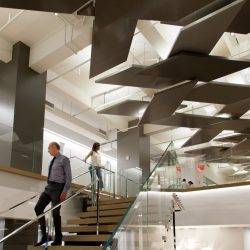 There is a growing body of research and understanding on the impact that working environments, workplace habits and culture have on people and broader business performance. The very best workplaces in the world – some of which will be on show at Workplace Week in New York next month – are changing our expectations around the look, function and purpose of office space. These workplaces are designed much like ecosystems – every inch designed with the comfort, wellbeing and productivity of the people who occupy them in mind. The new world of ‘workplace management’ is about designing and delivering multi-faceted, minute-by-minute, multi-sensory experiences that create an emotional response. It is about designing workplace experiences to deliver a specific mission. It encompasses thinking about journeys and destinations, the fusion of space, information, and services – and how these reflect organisational personality, support human effectiveness, and lure in talent. But, as those in the industry will be all too aware, this hasn’t always been the case. So, what’s to thank for this fresh approach to workplace design and management?
There is a growing body of research and understanding on the impact that working environments, workplace habits and culture have on people and broader business performance. The very best workplaces in the world – some of which will be on show at Workplace Week in New York next month – are changing our expectations around the look, function and purpose of office space. These workplaces are designed much like ecosystems – every inch designed with the comfort, wellbeing and productivity of the people who occupy them in mind. The new world of ‘workplace management’ is about designing and delivering multi-faceted, minute-by-minute, multi-sensory experiences that create an emotional response. It is about designing workplace experiences to deliver a specific mission. It encompasses thinking about journeys and destinations, the fusion of space, information, and services – and how these reflect organisational personality, support human effectiveness, and lure in talent. But, as those in the industry will be all too aware, this hasn’t always been the case. So, what’s to thank for this fresh approach to workplace design and management?
Up until now, the majority of relocations and / or change management projects have been driven from a financial perspective, and not from the hypothesis that a new way of working and culture may better support employees in the jobs they have been employed to do. Rising rents and rates and falling margins, however, are just the encouragement some organisations need to innovate in order to maximise human performance while making assets work harder and more financially responsibly. The emphasis has been 70% cost drivers and 30% user experience drivers.
In cities like London, however, where real estate is at a premium, that emphasis is beginning to shift from 70 – 30% to 50 – 50%. Soon, there should be equal buy-in between the benefits of providing excellent workplace or employee experiences, and the rewards reaped from driving utilisation and efficiency (i.e. watching the purse strings). In New York, real estate costs are not as high as in London, but they are getting higher. As a result, there appears to be a new appetite for different ways of working on both sides of the Atlantic – and for a more energised workplace where the experience is meticulously created and supported.
The global emphasis
Globally, the emphasis is now on creating workplaces that are not only functional and attractive but also conducive to establishing and supporting social cohesion, collaboration, interaction and engagement.
Due to financial drivers, activity based working is becoming commonplace in the UK and ‘change management’, the process of creating a new experience and culture, is becoming better understood as a result. In fact, it is seen as an increasingly normal thing to include when companies have a decision to make about a property, or when a lease is expiring. Every day, people are coming to us, asking for help with a project. Whereas, in the not too distant past, it was only the most innovative, forward-thinking and audacious companies pioneering these transformative workplace projects. Slowly-slowly, the scales are tipping and innovation is becoming the norm.
From the conversations we are having in the US, there is an appetite and growing recognition that a great workplace experience can impact engagement, morale, energy and performance. But the organisations that are actively championing such practice are still in the minority – with most of the shining examples dotted along the east coast or DC corridor. What Workplace Week New York – a week-long festival of workplace innovation – is trying to do is raise the level of awareness of these different ways of looking at the design and the delivery of the workplace, and how the workplace can be used as a powerful tool to transform the employee experience and improve an organisation’s bottom-line.
A new role
The most valuable assets in a modern organisation are its employees who are generating the value and returns in the business. So, the onus is on employers to create environments that generate positive workplace experiences and provide workers with the tools to boost wellbeing, engagement and productivity, and enable them to perform at their best. Designing the best possible workplace and employee experience is crucial to recruiting and retaining the best talent too.
Ultimately, the role of workplace management should be to determine the most effective experience and conditions for organisational and employee performance, effectively creating a baseline for any future design. The Workplace Management Framework – which has recently been adopted by the International Facility Management Association – aims to identify and maximise the strategic and economic benefit of the workplace as a business tool. The framework includes practical steps that organisations can take to develop a strategic workplace management function, which will be shared during Workplace Week New York next month and at Workplace Week London later in the year.
Workplace professionals have the ability to influence behaviour and contribute to individual and organisational success. Increasingly, workplace, FM and RE leaders can extend their role to get beyond simple ownership of assets to ownership of experience. To that end, more solid science is needed to help people understand the design process, rationale and narrative of the change required to make a positive difference to individual and collective needs. That’s where Workplace Week hopes to make a difference.
_______________________________
 Andrew Mawson is the owner of Advanced Workplace Associates and one of the world foremost researchers on workplace issues as part of the Center for Evidence Based Management
Andrew Mawson is the owner of Advanced Workplace Associates and one of the world foremost researchers on workplace issues as part of the Center for Evidence Based Management



















May 17, 2018
What exactly is driving the global workplace conversation?
by Andrew Mawson • Comment, Facilities management, Workplace design
Up until now, the majority of relocations and / or change management projects have been driven from a financial perspective, and not from the hypothesis that a new way of working and culture may better support employees in the jobs they have been employed to do. Rising rents and rates and falling margins, however, are just the encouragement some organisations need to innovate in order to maximise human performance while making assets work harder and more financially responsibly. The emphasis has been 70% cost drivers and 30% user experience drivers.
In cities like London, however, where real estate is at a premium, that emphasis is beginning to shift from 70 – 30% to 50 – 50%. Soon, there should be equal buy-in between the benefits of providing excellent workplace or employee experiences, and the rewards reaped from driving utilisation and efficiency (i.e. watching the purse strings). In New York, real estate costs are not as high as in London, but they are getting higher. As a result, there appears to be a new appetite for different ways of working on both sides of the Atlantic – and for a more energised workplace where the experience is meticulously created and supported.
The global emphasis
Globally, the emphasis is now on creating workplaces that are not only functional and attractive but also conducive to establishing and supporting social cohesion, collaboration, interaction and engagement.
Due to financial drivers, activity based working is becoming commonplace in the UK and ‘change management’, the process of creating a new experience and culture, is becoming better understood as a result. In fact, it is seen as an increasingly normal thing to include when companies have a decision to make about a property, or when a lease is expiring. Every day, people are coming to us, asking for help with a project. Whereas, in the not too distant past, it was only the most innovative, forward-thinking and audacious companies pioneering these transformative workplace projects. Slowly-slowly, the scales are tipping and innovation is becoming the norm.
From the conversations we are having in the US, there is an appetite and growing recognition that a great workplace experience can impact engagement, morale, energy and performance. But the organisations that are actively championing such practice are still in the minority – with most of the shining examples dotted along the east coast or DC corridor. What Workplace Week New York – a week-long festival of workplace innovation – is trying to do is raise the level of awareness of these different ways of looking at the design and the delivery of the workplace, and how the workplace can be used as a powerful tool to transform the employee experience and improve an organisation’s bottom-line.
A new role
The most valuable assets in a modern organisation are its employees who are generating the value and returns in the business. So, the onus is on employers to create environments that generate positive workplace experiences and provide workers with the tools to boost wellbeing, engagement and productivity, and enable them to perform at their best. Designing the best possible workplace and employee experience is crucial to recruiting and retaining the best talent too.
Ultimately, the role of workplace management should be to determine the most effective experience and conditions for organisational and employee performance, effectively creating a baseline for any future design. The Workplace Management Framework – which has recently been adopted by the International Facility Management Association – aims to identify and maximise the strategic and economic benefit of the workplace as a business tool. The framework includes practical steps that organisations can take to develop a strategic workplace management function, which will be shared during Workplace Week New York next month and at Workplace Week London later in the year.
Workplace professionals have the ability to influence behaviour and contribute to individual and organisational success. Increasingly, workplace, FM and RE leaders can extend their role to get beyond simple ownership of assets to ownership of experience. To that end, more solid science is needed to help people understand the design process, rationale and narrative of the change required to make a positive difference to individual and collective needs. That’s where Workplace Week hopes to make a difference.
_______________________________